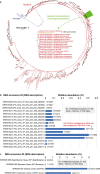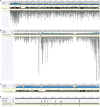Large freshwater phages with the potential to augment aerobic methane oxidation
- PMID: 32839536
- PMCID: PMC7674155
- DOI: 10.1038/s41564-020-0779-9
Large freshwater phages with the potential to augment aerobic methane oxidation
Abstract
There is growing evidence that phages with unusually large genomes are common across various microbiomes, but little is known about their genetic inventories or potential ecosystem impacts. In the present study, we reconstructed large phage genomes from freshwater lakes known to contain bacteria that oxidize methane. Of manually curated genomes, 22 (18 are complete), ranging from 159 kilobase (kb) to 527 kb in length, were found to encode the pmoC gene, an enzymatically critical subunit of the particulate methane monooxygenase, the predominant methane oxidation catalyst in nature. The phage-associated PmoC sequences show high similarity to (>90%), and affiliate phylogenetically with, those of coexisting bacterial methanotrophs, including members of Methyloparacoccus, Methylocystis and Methylobacter spp. In addition, pmoC-phage abundance patterns correlate with those of the coexisting bacterial methanotrophs, supporting host-phage relationships. Future work is needed to determine whether phage-associated PmoC has similar functions to additional copies of PmoC encoded in bacterial genomes, thus contributing to growth on methane. Transcriptomics data from Lake Rotsee (Switzerland) showed that some phage-associated pmoC genes were highly expressed in situ and, of interest, that the most rapidly growing methanotroph was infected by three pmoC-phages. Thus, augmentation of bacterial methane oxidation by pmoC-phages during infection could modulate the efflux of this potent greenhouse gas into the environment.
Conflict of interest statement
The authors declare no competing interests.
Figures








References
-
- Salmond GPC, Fineran PC. A century of the phage: past, present and future. Nat. Rev. Microbiol. 2015;13:777–786. - PubMed
-
- Mann NH, Cook A, Millard A, Bailey S, Clokie M. Bacterial photosynthesis genes in a virus. Nature. 2003;424:741–741. - PubMed
-
- Anantharaman K, et al. Sulfur oxidation genes in diverse deep-sea viruses. Science. 2014;344:757–760. - PubMed
Publication types
MeSH terms
Substances
LinkOut - more resources
Full Text Sources
Other Literature Sources
Miscellaneous

